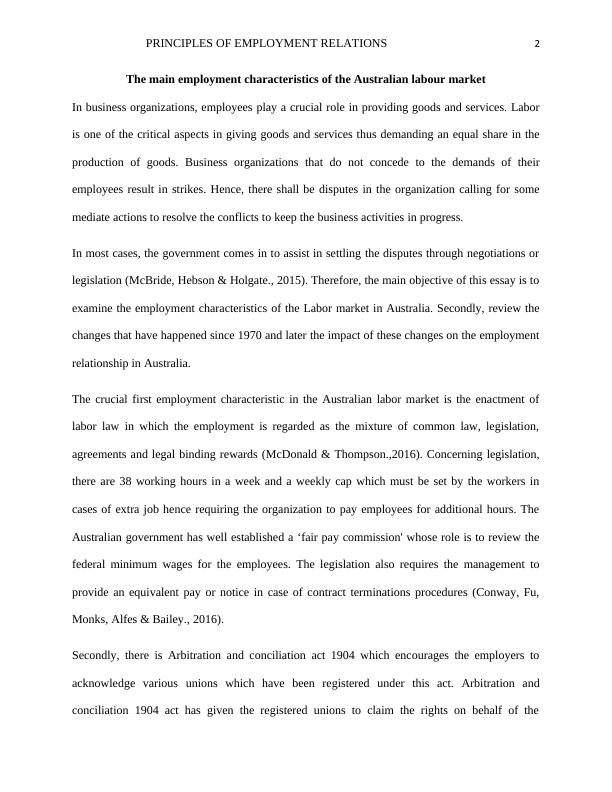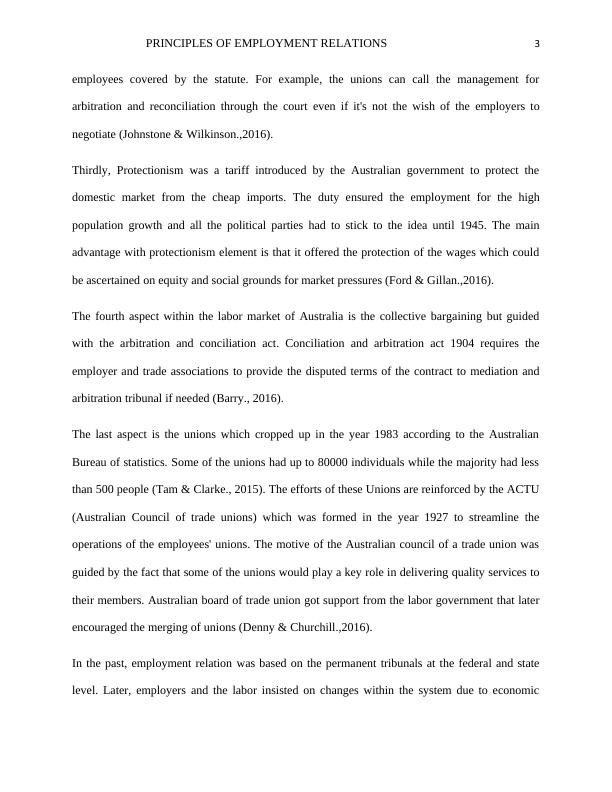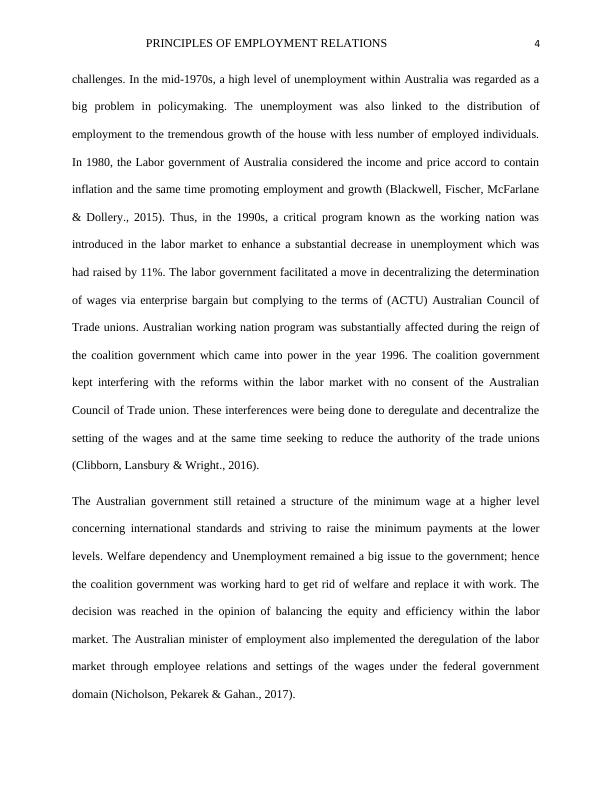Principles of Employment Relations
Added on 2023-01-19
13 Pages3716 Words34 Views
Running head: PRINCIPLES OF EMPLOYMENT RELATIONS 1
Principles of employment relations
Students name
Professor’s name
Institutional affiliation
Date
Principles of employment relations
Students name
Professor’s name
Institutional affiliation
Date

PRINCIPLES OF EMPLOYMENT RELATIONS 2
The main employment characteristics of the Australian labour market
In business organizations, employees play a crucial role in providing goods and services. Labor
is one of the critical aspects in giving goods and services thus demanding an equal share in the
production of goods. Business organizations that do not concede to the demands of their
employees result in strikes. Hence, there shall be disputes in the organization calling for some
mediate actions to resolve the conflicts to keep the business activities in progress.
In most cases, the government comes in to assist in settling the disputes through negotiations or
legislation (McBride, Hebson & Holgate., 2015). Therefore, the main objective of this essay is to
examine the employment characteristics of the Labor market in Australia. Secondly, review the
changes that have happened since 1970 and later the impact of these changes on the employment
relationship in Australia.
The crucial first employment characteristic in the Australian labor market is the enactment of
labor law in which the employment is regarded as the mixture of common law, legislation,
agreements and legal binding rewards (McDonald & Thompson.,2016). Concerning legislation,
there are 38 working hours in a week and a weekly cap which must be set by the workers in
cases of extra job hence requiring the organization to pay employees for additional hours. The
Australian government has well established a ‘fair pay commission' whose role is to review the
federal minimum wages for the employees. The legislation also requires the management to
provide an equivalent pay or notice in case of contract terminations procedures (Conway, Fu,
Monks, Alfes & Bailey., 2016).
Secondly, there is Arbitration and conciliation act 1904 which encourages the employers to
acknowledge various unions which have been registered under this act. Arbitration and
conciliation 1904 act has given the registered unions to claim the rights on behalf of the
The main employment characteristics of the Australian labour market
In business organizations, employees play a crucial role in providing goods and services. Labor
is one of the critical aspects in giving goods and services thus demanding an equal share in the
production of goods. Business organizations that do not concede to the demands of their
employees result in strikes. Hence, there shall be disputes in the organization calling for some
mediate actions to resolve the conflicts to keep the business activities in progress.
In most cases, the government comes in to assist in settling the disputes through negotiations or
legislation (McBride, Hebson & Holgate., 2015). Therefore, the main objective of this essay is to
examine the employment characteristics of the Labor market in Australia. Secondly, review the
changes that have happened since 1970 and later the impact of these changes on the employment
relationship in Australia.
The crucial first employment characteristic in the Australian labor market is the enactment of
labor law in which the employment is regarded as the mixture of common law, legislation,
agreements and legal binding rewards (McDonald & Thompson.,2016). Concerning legislation,
there are 38 working hours in a week and a weekly cap which must be set by the workers in
cases of extra job hence requiring the organization to pay employees for additional hours. The
Australian government has well established a ‘fair pay commission' whose role is to review the
federal minimum wages for the employees. The legislation also requires the management to
provide an equivalent pay or notice in case of contract terminations procedures (Conway, Fu,
Monks, Alfes & Bailey., 2016).
Secondly, there is Arbitration and conciliation act 1904 which encourages the employers to
acknowledge various unions which have been registered under this act. Arbitration and
conciliation 1904 act has given the registered unions to claim the rights on behalf of the

PRINCIPLES OF EMPLOYMENT RELATIONS 3
employees covered by the statute. For example, the unions can call the management for
arbitration and reconciliation through the court even if it's not the wish of the employers to
negotiate (Johnstone & Wilkinson.,2016).
Thirdly, Protectionism was a tariff introduced by the Australian government to protect the
domestic market from the cheap imports. The duty ensured the employment for the high
population growth and all the political parties had to stick to the idea until 1945. The main
advantage with protectionism element is that it offered the protection of the wages which could
be ascertained on equity and social grounds for market pressures (Ford & Gillan.,2016).
The fourth aspect within the labor market of Australia is the collective bargaining but guided
with the arbitration and conciliation act. Conciliation and arbitration act 1904 requires the
employer and trade associations to provide the disputed terms of the contract to mediation and
arbitration tribunal if needed (Barry., 2016).
The last aspect is the unions which cropped up in the year 1983 according to the Australian
Bureau of statistics. Some of the unions had up to 80000 individuals while the majority had less
than 500 people (Tam & Clarke., 2015). The efforts of these Unions are reinforced by the ACTU
(Australian Council of trade unions) which was formed in the year 1927 to streamline the
operations of the employees' unions. The motive of the Australian council of a trade union was
guided by the fact that some of the unions would play a key role in delivering quality services to
their members. Australian board of trade union got support from the labor government that later
encouraged the merging of unions (Denny & Churchill.,2016).
In the past, employment relation was based on the permanent tribunals at the federal and state
level. Later, employers and the labor insisted on changes within the system due to economic
employees covered by the statute. For example, the unions can call the management for
arbitration and reconciliation through the court even if it's not the wish of the employers to
negotiate (Johnstone & Wilkinson.,2016).
Thirdly, Protectionism was a tariff introduced by the Australian government to protect the
domestic market from the cheap imports. The duty ensured the employment for the high
population growth and all the political parties had to stick to the idea until 1945. The main
advantage with protectionism element is that it offered the protection of the wages which could
be ascertained on equity and social grounds for market pressures (Ford & Gillan.,2016).
The fourth aspect within the labor market of Australia is the collective bargaining but guided
with the arbitration and conciliation act. Conciliation and arbitration act 1904 requires the
employer and trade associations to provide the disputed terms of the contract to mediation and
arbitration tribunal if needed (Barry., 2016).
The last aspect is the unions which cropped up in the year 1983 according to the Australian
Bureau of statistics. Some of the unions had up to 80000 individuals while the majority had less
than 500 people (Tam & Clarke., 2015). The efforts of these Unions are reinforced by the ACTU
(Australian Council of trade unions) which was formed in the year 1927 to streamline the
operations of the employees' unions. The motive of the Australian council of a trade union was
guided by the fact that some of the unions would play a key role in delivering quality services to
their members. Australian board of trade union got support from the labor government that later
encouraged the merging of unions (Denny & Churchill.,2016).
In the past, employment relation was based on the permanent tribunals at the federal and state
level. Later, employers and the labor insisted on changes within the system due to economic

PRINCIPLES OF EMPLOYMENT RELATIONS 4
challenges. In the mid-1970s, a high level of unemployment within Australia was regarded as a
big problem in policymaking. The unemployment was also linked to the distribution of
employment to the tremendous growth of the house with less number of employed individuals.
In 1980, the Labor government of Australia considered the income and price accord to contain
inflation and the same time promoting employment and growth (Blackwell, Fischer, McFarlane
& Dollery., 2015). Thus, in the 1990s, a critical program known as the working nation was
introduced in the labor market to enhance a substantial decrease in unemployment which was
had raised by 11%. The labor government facilitated a move in decentralizing the determination
of wages via enterprise bargain but complying to the terms of (ACTU) Australian Council of
Trade unions. Australian working nation program was substantially affected during the reign of
the coalition government which came into power in the year 1996. The coalition government
kept interfering with the reforms within the labor market with no consent of the Australian
Council of Trade union. These interferences were being done to deregulate and decentralize the
setting of the wages and at the same time seeking to reduce the authority of the trade unions
(Clibborn, Lansbury & Wright., 2016).
The Australian government still retained a structure of the minimum wage at a higher level
concerning international standards and striving to raise the minimum payments at the lower
levels. Welfare dependency and Unemployment remained a big issue to the government; hence
the coalition government was working hard to get rid of welfare and replace it with work. The
decision was reached in the opinion of balancing the equity and efficiency within the labor
market. The Australian minister of employment also implemented the deregulation of the labor
market through employee relations and settings of the wages under the federal government
domain (Nicholson, Pekarek & Gahan., 2017).
challenges. In the mid-1970s, a high level of unemployment within Australia was regarded as a
big problem in policymaking. The unemployment was also linked to the distribution of
employment to the tremendous growth of the house with less number of employed individuals.
In 1980, the Labor government of Australia considered the income and price accord to contain
inflation and the same time promoting employment and growth (Blackwell, Fischer, McFarlane
& Dollery., 2015). Thus, in the 1990s, a critical program known as the working nation was
introduced in the labor market to enhance a substantial decrease in unemployment which was
had raised by 11%. The labor government facilitated a move in decentralizing the determination
of wages via enterprise bargain but complying to the terms of (ACTU) Australian Council of
Trade unions. Australian working nation program was substantially affected during the reign of
the coalition government which came into power in the year 1996. The coalition government
kept interfering with the reforms within the labor market with no consent of the Australian
Council of Trade union. These interferences were being done to deregulate and decentralize the
setting of the wages and at the same time seeking to reduce the authority of the trade unions
(Clibborn, Lansbury & Wright., 2016).
The Australian government still retained a structure of the minimum wage at a higher level
concerning international standards and striving to raise the minimum payments at the lower
levels. Welfare dependency and Unemployment remained a big issue to the government; hence
the coalition government was working hard to get rid of welfare and replace it with work. The
decision was reached in the opinion of balancing the equity and efficiency within the labor
market. The Australian minister of employment also implemented the deregulation of the labor
market through employee relations and settings of the wages under the federal government
domain (Nicholson, Pekarek & Gahan., 2017).

End of preview
Want to access all the pages? Upload your documents or become a member.
Related Documents
Arbitration and conciliation Question and Answer 2022lg...
|10
|2736
|30
Industrial Relations and Stakeholder Participation in Australialg...
|28
|7409
|321
Managing Workplace Relations: Relevant Laws and Actslg...
|6
|1253
|41
Industrial Relation Management PDFlg...
|8
|1637
|118
Enterprise Bargaining in Sear Corporationlg...
|13
|3146
|375
Industrial Relation Assessment PDFlg...
|14
|3373
|12
